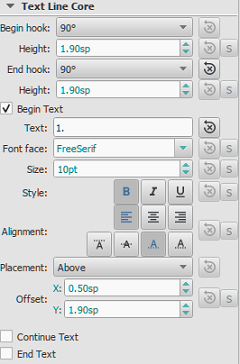Voltas
Volta brackets, or first and second ending brackets, are lines used to mark different endings for a simple repeat. Score playback automatically follows the repeat indications.

To add a volta to the score
Use one of the following methods:
- Select a measure, or range of measures and click a Volta icon in the Lines palette (double-click in versions prior to 3.4).
- Drag-and-drop a volta from the Lines palette, then adjust the length as required (see below).
To change the number of measures that a volta covers
- Go into Edit mode on the volta. The end handle is automatically selected.
- Press Shift+→ to move the end handle forward one measure. Press Shift+← to move the handle backward one measure. Repeat as required.
Note: When you select a start or end handle, a dashed line appears connecting it to an anchor point on the staff (see diagram, below). This anchor shows the position of the playback start/end points of the Volta. The Shift commands change the anchor point so playback always remains in sync with the visual start/end points. To make fine adjustments to the visual start or end points, without affecting playback, use other keyboard arrow commands, or drag the handles with a mouse.

Volta properties
To make changes to Volta text:
-
Select the volta, and edit the properties in the Text Line Core section of the Inspector.

To specify the order of repeats:
- Select the volta, and in "Repeat list" (Volta section of the Inspector) type in a number, or sequence of numbers separated by commas, to indicate the repeat(s) in which the volta is to be played.

For example, a first ending shows the number "1"; a second ending, the number "2" and so on. More complex repeats are also possible: e.g. a "Repeat list" displaying "1, 2, 4, 5, 7" indicates that the volta is to be played during repeats 1, 2, 4, 5, and 7, and so on.
Note: Each volta section, except the final one, should end with an end repeat barline.
Note: Keep in mind that the repeat is always referenced in comparison to it's starting point (either the most recent start repeat barline or the start of the current section).
Playback
Sometimes a repeat plays more than two times. If you want to change the number of times MuseScore plays a repeat, go to the measure containing the end repeat barline and change its "Play count". See Measure operations: Other properties and the note on playback for voltas in Repeats and jumps.
Play count
The play count of the measure with the end repeat barline must be set (at least) one higher than the number of times you want the measure to play (this is usually equal to the number of entries in that volta repeat list + 1).
Take the following score:

Measure 4 should have play count set to 4
Measure 6 should have play count set to 3
External links
- MuseScore in Minutes, Lesson 8: Repeats and Endings, Part 1 (Video tutorial for MuseScore 2)
- How to create ties leading into a 2nd ending (MuseScore HowTo)